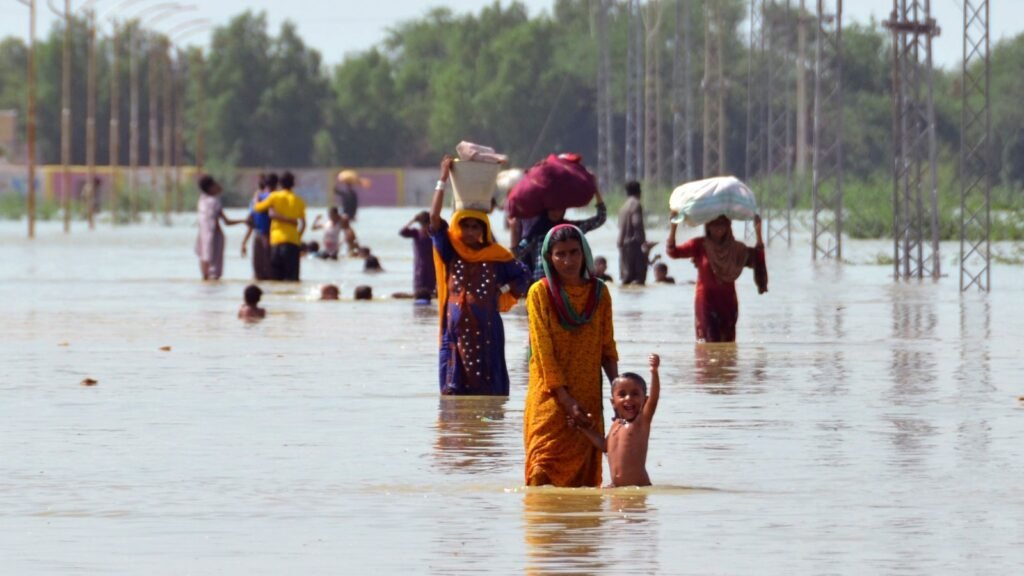Pakistan’s devastating 2022 mega-flood, which claimed nearly 1,500 lives and caused over $30 billion in economic losses, may only be a glimpse of what lies ahead as climate change accelerates. A comprehensive study conducted by five researchers Arfan Arshad, Ali Mirchi, Cenlin He, Azeem Ali Shah and Amir Agha and appeared in Nature has found that the convergence of human-driven (anthropogenic) and climatic forces led to the catastrophic inundation in Sindh and Balochistan—an event that could become more frequent and severe under future warming scenarios.
Researchers warn that by the year 2099, extreme multi-day rainfall events like those of July and August 2022 could increase significantly in frequency and magnitude, especially under the high-emissions scenario known as SSP5-8.5. In that case, events currently considered “once-in-500-years” could occur multiple times in a single century.
From Drought to Deluge: A Dangerous Pattern
The 2022 flood was unusual not only for its scale but for the sequence of events leading up to it. After years of drought in southern Pakistan, pre-monsoon rainfall surged to 111% above the historical average (1951–2021), saturating soils in the Indus Basin. This was followed by an unprecedented 547% increase in monsoon rainfall, pushing already vulnerable systems past their breaking point.
Notably, extreme rain-on-snow events and heat-induced glacier melt in the upstream Hindu Kush–Himalayan ranges contributed to swollen rivers. At Sukkur Barrage, streamflow was recorded at 170% higher than the historical average—significantly intensifying flood risks downstream.
“Pakistan is already at the frontlines of climate change,” the study notes, “but what we witnessed in 2022 is only a forewarning.”
Future Projections: What’s Coming
Scientists have used advanced modeling (ProNEVA) and remote sensing data to forecast future risks. Under a 2.0 °C global warming scenario (which is highly plausible this century), flood impacts in Pakistan could rise by over 500% compared to the 1981–2010 baseline. The country’s glacier area is projected to shrink by 55%, raising the likelihood of flash floods driven by glacial lake outbursts and snowmelt-accelerated river flows.
Pakistan has already experienced 19 major flood disasters since 1950, but the pace and severity are expected to intensify drastically. Atmospheric rivers—moisture channels responsible for large-scale precipitation—are projected to become stronger and more frequent in South Asia, creating further instability.
Pakistan’s Fragile Readiness
Despite being among the top ten nations most exposed to climate risks, Pakistan’s investment in flood prevention infrastructure and urban drainage remains grossly insufficient. Urban centers like Karachi, Lahore, Islamabad, and Hyderabad suffer regular flash flooding during monsoon seasons due to poor planning, encroachments on floodplains, and weak governance.
With rising sea surface temperatures in the Arabian Sea and increasing moisture transport during the monsoon trough, southern Pakistan remains highly exposed. In 2022, Jacobabad recorded rainfall equivalent to a 728% increase over its average, while Larkana and Hyderabad saw increases of 934% and 532%, respectively.
The Kalat region recorded a 7-day rainfall event with a 425-year return period, now effectively shortened due to the impact of the 2022 data. Without urgent adaptation, what was once considered a rare disaster could become routine.
What Needs to Change?

Experts emphasize that risk forecasting, hydrological modeling, and infrastructure upgrades must be treated as national priorities. The government must scale up early warning systems, enforce zoning regulations to prevent floodplain encroachment, and invest in large-scale drainage and reservoir systems.
In parallel, climate diplomacy will play a critical role. Pakistan contributes less than 1% to global carbon emissions, yet bears an outsized share of the damage. Calls for climate financing, especially for adaptation and loss and damage, are growing louder.
A National Wake-Up Call
The 2022 floods were not just an environmental crisis—they were a humanitarian and economic emergency. Over 4 million hectares of farmland were submerged, livelihoods were destroyed, and a third of the country was left waterlogged for weeks.
If the world continues on its current emissions path, similar and even more devastating events could strike Pakistan every few years. With the Himalayan glaciers retreating, the Arabian Sea warming, and monsoons growing erratic, the need for climate-resilient infrastructure, smart urban planning, and regional collaboration has never been more urgent.
